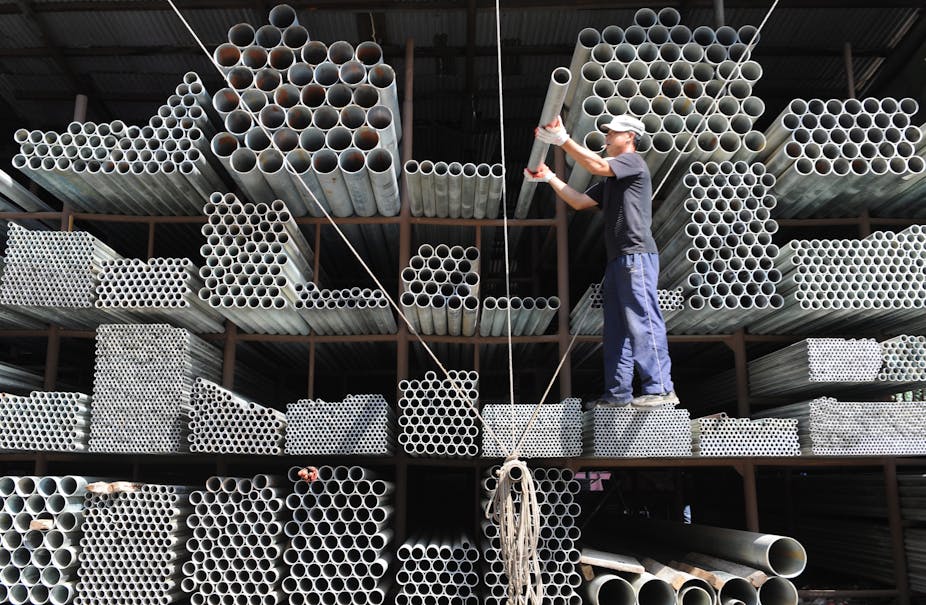Rapid increases in energy efficiency in Chinese manufacturing, especially in the steel production sector, will temper demand for Australian coal exports and put billions of dollars in investment at risk.
A new report, released by the Smith School of Enterprise and the Environment at the University of Oxford, found up to A$50 billion in mining investment – including the Alpha Coal, China First, Wandoan and Mt Pleasant projects – could be “stranded”, leading to write-downs or “conversion to liabilities”.

Oversupply by Indonesia, Australia and the US, driven by “over-optimistic predictions for the demand for coal and therefore of the coal price” had forced the coal price down 30% from 2011 to the beginning of 2013.
The report warned weaker Chinese demand and the planned doubling of Australia’s coal production by 2020 would see prices fall further. Already 15% of coal mined in Australia is extracted at a loss.
While China’s demand for coal won’t fall in absolute terms, the report found it would not grow fast enough to support new mega projects.
China’s latest five year plan, covering 2011 to 2015, aggressively pushes for a reduction in non-renewable resource consumption.
A carbon tax is expected to start next year, while provincial emissions trading schemes are to be implemented nationwide by 2015.
The researchers found the emission trading scheme would have a “moderate” impact on coal consumption in the short and long term. But they found that “the impact on coal prices would be slight in the short term, moderate in the medium term and potentially significant in the long term”.
A serious pollution problem and a rising tide of unhappiness in large cities affected by smog is one reason the Chinese government may be moving forward with these environmental policies, according to Mark Beeson, a Professor of International Politics at Murdoch University.
“One of the main things that galvanises the Chinese government is any chance of social unrest, and it’s interesting to see protests on this. They haven’t been on a mass scale, but they are happening and that must be alarming as far as the central government is concerned,” Professor Beeson said.
“This is the kind of context that these changes are unfolding in, but of course there is a continued reliance on coal as a cheap source of energy.”
The most significant driver of coal imports to China was a lack of energy efficiency. The report found the amount of energy used per unit of GDP tripled between 1950 and 1978. But energy efficiency has improved by 47% since 1990.

Government programs, for instance, are pushing together small-scale steel producers, which had emerged during the rapid growth of the industry. With greater scale, these firms are able to fund investment in research and technology upgrades to raise levels of energy efficiency.
If China closes the energy efficiency gap in steel manufacturing with China, as planned by 2020, it could result in a decrease in coal use of 40% per unit of output.
And this shift “would have a particular impact on Australian coal exporters, which are the largest suppliers of coking coal [needed in steel production] to China”, according to the report.
John Mathews, a Professor of Strategic Management at the Macquarie Graduate School of Management, attributed some of the weakness in demand to a fast growth in renewable energy use in China.
The International Energy Agency estimates 28% of China’s electricity will be generated by renewables by 2035.
But Professor Mathews said this is not because the Chinese leadership is concerned about global warming.
“[They’re] concerned over energy security. If they continued with business as usual and built a coal fired economy at the same rate as was done by the West over the previous 200 years, they would be facing almost certain wars over access to fossil fuels,” he said.
“What drives China ultimately is building energy security over what they can control themselves, which is manufacturing. They can do that and they are very good at scaling that up and reaping the increasing returns.”
“Of course once they have scaled up, they can go to international negotiations over carbon reductions and say ‘this is what we’ve done to reduce our carbon emissions, what are you doing?’”
Professor Beeson said the focus on energy security was not surprising, and the Chinese government was putting in place policies that would advantage themselves commercially, in “a tradition of neo-mercantilism in East Asia”.
The Chinese solar power component industry is one of the biggest in the world, with enormous tax breaks and other government assistance.
The report found that if China met its renewable energy plan, total coal consumption would fall by 5% by 2020.

